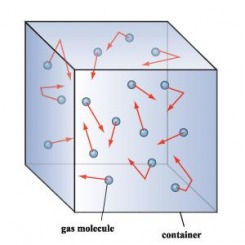Ideal gas is the gas that obeys all the gas laws (Boyle's, Charles's and Avogadro's law).
Basic assumptions:
(a) The gas molecules are in continuous and random motion.

(b) The collisions between gas molecules are perfectly elastic (no loss of kinetic energy).

(c) The volume of gas molecules is negligible as compared to the volume of its container. It is because the gas consists of tiny particles which are far apart from each other. There are a lot of empty spaces between gas molecules.
(d) The intermolecular (attractive or repulsive) forces between gas molecules are negligible.
2. van der Waals equation
Real gases deviate significantly from ideal gas behaviour at low temperature and high pressure. In 1873, the Dutch physicist, Johannes van der Waals developed an explanation for these deviations and an equation that was able to fit the behaviour of real gases over a much wider range of pressures.
The deviation from ideal gas behaviour is caused by:
(a) Existence of intermolecular attractive forces between gas molecules
- The assumption of kinetic molecular theory states that there is no intermolecular (attractive and repulsive) forces between gas molecules cannot be true. If it was true, gases would never condense to form liquids.

- In reality, there is small intermolecular attractive forces between gas molecules that tends to hold the molecules together. As a result, gases can condense to form liquids at low temperature.
- The intermolecular attractive forces exerted by its neighbouring molecules reduce the speed of a gas molecule that is moving towards the wall of the container. Consequently, the gas molecules move slower and give less impact to the wall.
- As a result, the pressure exerted by real gas is less than expected from ideal gas.
(b) Finite molecular volume of the gas molecules
- The assumption of kinetic molecular theory states that the volume of gas molecules is negligible as compared to the volume of its container works well at low pressure (pressure close to 1 atm).
- At high presure, real gases are not as compressible as an ideal gas. The volume of a real gas is therefore larger than expected from ideal gas at high pressure.
- In reality, the gas molecules occupy a certain amount of space in the container. The actual volume available for the gas molecules to move about is always less than the observed volume (volume of the container, Vcontainer).
- The volume occupied by the gas molecules which their movement is restriced in that area is called excluded volume.
- Actual volume (or effective volume) = Vcontainer – Voccupied by gas molecules

where a = constant to correct for intermolecular attractive forces
b = constant to correct for volume occupied by gas molecules

3. Conditions at which gases deviate from ideal gas behaviour
(a) High pressure
- The gas molecules are close to each other.
- The volume occupied by the gas molecules is significant as compared to the volume of its container.
- The interaction (attractive and repulsive) between gas molecules is significant.
- The kinetic energy of gas molecules decreases.
- The gas molecules are close to each other.
- The interaction (attractive and repulsive) between gas molecules is significant.
4. Conditions at which real gases approach ideal behaviour
(a) Low pressure
- The gas molecules are far apart from each other.
- The volume occupied by gas molecules is negligible since they only occupy a small fraction as compared to the volume of its container.
- The interaction (attractive and repulsive) between gas molecules is negligible.
- The kinetic energy of gas molecules increases.
- The gas molecules are able to overcome the intermolecular attractive forces between them.
- The interaction (attractive and repulsive) between gas molecules is negligible.
No comments:
Post a Comment